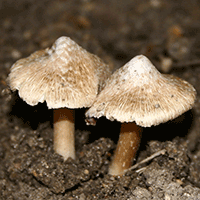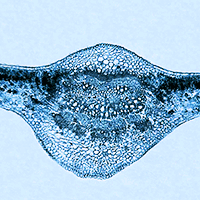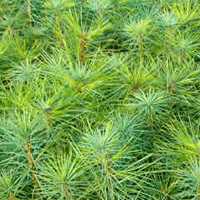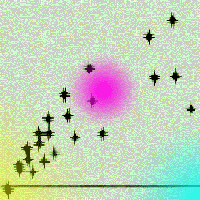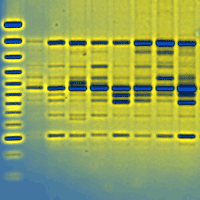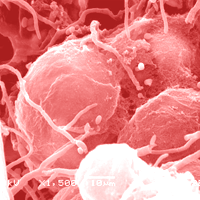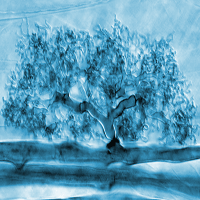Ectomycorrhizal communities are rarely studied on seasonal basis, especially in poplar plantations. In this study we analysed the ectomycorrhizal community in a mature twenty-year-old white poplar (Populus alba L.) plantation during four consecutive seasons. Using morpho-anatomical and molecular identification 30 taxa of ectomycorrhizal fungi were recorded of which 15 were identified to the species level, 12 to the genus level, 2 to the family, and one morphotype of ectomycorrhizae remained unidentified. The most abundant among identified ectomycorrhizal fungi were: Inocybe griseovelata, Inocybe splendens, Tuber rufum, and Tomentella sp. 2, which together represented up to 50% of all ectomycorrhizal root tips. The number of ectomycorrhizal fungal taxa and the percentage of vital ectomycorrhizal root tips were highest in winter and spring, respectively. The diversity indices of ectomycorrhizae, number of vital ectomycorrhizal root tips, and total fine roots in the studied poplar plantation did not differ between seasons. Ectomycorrhizal fungi belonging to Inocybaceae family and the short-distance exploration strategy were dominant in all four seasons. On the other hand, the abundance of ectomycorrhizal root tips belonging to the medium-distance exploration strategy type was significantly higher in spring in comparison with autumn and winter.
Keywords
, , , ,
Citation
Milović M, Orlović S, Grebenc T, Bajc M, Kovačević B, Kraigher H (2021). Ectomycorrhizal fungal community in mature white poplar plantation. iForest 14: 540-547. - doi: 10.3832/ifor3827-014
Academic Editor
Maurizio Ventura
Paper history
Received: Mar 26, 2021
Accepted: Sep 24, 2021
First online: Nov 26, 2021
Publication Date: Dec 31, 2021
Publication Time: 2.10 months
© SISEF - The Italian Society of Silviculture and Forest Ecology 2021
Open Access
This article is distributed under the terms of the Creative Commons Attribution-Non Commercial 4.0 International (https://creativecommons.org/licenses/by-nc/4.0/), which permits unrestricted use, distribution, and reproduction in any medium, provided you give appropriate credit to the original author(s) and the source, provide a link to the Creative Commons license, and indicate if changes were made.

Breakdown by View Type
(Waiting for server response...)
Article Usage
Total Article Views: 31532
(from publication date up to now)
Breakdown by View Type
HTML Page Views: 26946
Abstract Page Views: 2224
PDF Downloads: 1829
Citation/Reference Downloads: 2
XML Downloads: 531
Web Metrics
Days since publication: 1504
Overall contacts: 31532
Avg. contacts per week: 146.76
Article Citations
Article citations are based on data periodically collected from the Clarivate Web of Science web site
(last update: Mar 2025)
Total number of cites (since 2021): 2
Average cites per year: 0.40
Publication Metrics
by Dimensions ©
Articles citing this article
List of the papers citing this article based on CrossRef Cited-by.
(1)
Agerer R (1991)Characterisation of ectomycorrhiza. Techniques for the study of mycorrhiza In: “Methods in Microbiology vol. 23” (Norris JR, Read DJ, Varma AK eds). Academic Press, London, UK, pp. 25-72.
Gscholar
(2)
Agerer R (2001)Exploration types of ectomycorrhizae. A proposal to classify ECM mycelial systems according to their patterns of differentiation and putative ecological importance. Mycorrhiza 11 (2): 107-114.
CrossRef |
Gscholar
(3)
Agerer R, Danielson RM, Egli S, Ingleby K, Luoma D, Treu R (2006)Descriptions of ectomycorrhizae - vol. 10. Einhorn-Verlag, Schwäbisch Gmünd, Germany.
Gscholar
(4)
Agerer R (2008)Colour atlas of ectomycorrhizae (13th edn). Einhorn-Verlag, Schwäbisch Gmünd, Germany.
Gscholar
(5)
Agerer R, Rambold G (2020)DEEMY - An information system for characterization and determination of ectomycorrhizae. München, Germany, web site.
Online |
Gscholar
(6)
Atlas R, Bartha R (1981)Introduction to microbiology. Addison-Wesley Publishing Company, Reading, UK, pp. 242-244.
Gscholar
(7)
Bartlett MS (1936)The square root transformation in analysis of variance. Supplement to Journal of the Royal Statistical Society 3: 68-78.
CrossRef |
Gscholar
(8)
Buée M, Vairelles D, Garbaye J (2005)Year-round monitoring of diversity and potential metabolic activity of the ectomycorrhizal community in a beech (
Fagus sylvatica) forest subjected to two thinning regimes. Mycorrhiza 15: 235-245.
CrossRef |
Gscholar
(9)
Chao A, Chiu CH (2016)Species richness: estimation and comparison. Wiley StatsRef: Statistics Reference Online, pp. 1-26.
CrossRef |
Gscholar
(10)
Courty PE, Frank A, Pierrat JC, Garbaye J (2008)Temporal changes in the ectomycorrhizal community in two soil horizons of a temperate oak forest. Applied and Environmental Microbiology 74: 5792-5801.
CrossRef |
Gscholar
(11)
Cripps CL (2001)Mycorrhizae of aspen forests: ecology and potential application. In: Proceedings of the Symposium “Sustaining Aspen in Western Landscapes”. Grand Junction (CO, USA), 13-15 June 2000, pp. 285-298.
Gscholar
(12)
Cripps CL (2003)Native mycorrhizal fungi with aspen on smelter-impacted sites in the Northern Rocky Mountains: occurrence and potential use in reclamation. In: Proceedings of the National Meeting of the American Society of Mining and Reclamation and the 9th Billings Land Reclamation Symposium. Billings (MT, USA) 3-6 June 2003. ASMR, Lexington, KY, USA, pp. 193-208.
Online |
Gscholar
(13)
Danielsen L, Thürmer A, Meinicke P, Buée M, Morin E, Martin F, Pilate G, Daniel R, Polle A, Reich M (2002)Fungal soil communities in a young transgenic poplar plantation form a rich reservoir for fungal root communities. Ecology and Evolution 2 (8): 1935-48.
CrossRef |
Gscholar
(14)
De Roman M, De Miguel AM (2005)Post-fire, seasonal and annual dynamics of the ectomycorrhizal community in a
Quercus ilex L. forest over a 3-year period. Mycorrhiza 15: 471-482.
CrossRef |
Gscholar
(15)
Defrenne CE, Philpott TJ, Guichon SHA, Roach WJ, Pickles BJ, Simard SW (2019)Shifts in ectomycorrhizal fungal communities and exploration types relate to the environment and fine-root traits across interior Douglas-fir forests of Western Canada. Frontiers in Plant Science 10: 643.
CrossRef |
Gscholar
(16)
Gardes M, Bruns TD (1993)ITS primers with enhanced specificity for basidiomycetes-application to the identification of mycorrhizae and rusts. Molecular Ecology 2: 113-118.
CrossRef |
Gscholar
(17)
Hrynkiewicz K, SzymaA, Piernik A, Thiem D (2015)Ectomycorrhizal community structure of
Salix and
Betula spp. at a saline site in Central Poland in relation to the seasons and soil parameters. Water, Air and Soil Pollution: 226 (4): 99.
CrossRef |
Gscholar
(18)
Ishida T, Nara K, Kazuhide T, Tanaka M, Kinoshita A, Hogetsu T (2008)Germination and infectivity of ectomycorrhizal fungal spores in relation to their ecological traits during primary succession. New Phytology 180: 491-500.
CrossRef |
Gscholar
(19)
Jakucs E (2002)Ectomycorrhizae of
Populus alba L. in south Hungary. Phyton 42: 199-210.
Online |
Gscholar
(20)
Kaldorf M, Renker C, Fladung M, Buscot F (2004)Characterization and spatial distribution of ectomycorrhizas colonizing aspen clones released in an experimental field. Mycorrhiza 14: 295-306.
CrossRef |
Gscholar
(21)
Karlinski L, Rudawska M, Kieliszewska-Rokicka B, Leski T (2010)Relationship between genotype and soil environment during colonization of poplar roots by mycorrhizal and endophytic fungi. Mycorrhiza 20: 315-324.
CrossRef |
Gscholar
(22)
Karlinski L, Rudawska M, Leski T (2013)The influence of host genotype and soil conditions on ectomycorrhizal community of poplar clones. European Journal of Soil Biology 58: 51-58.
CrossRef |
Gscholar
(23)
Katanić M, Grebenc T, Hrenko M, Stupar B, Galić Z, Orlović S, Kraigher H (2008)First identification of types of ectomycorrhiza in white poplar (
Populus alba L.) stand in vicinity of Novi Sad. Topola/Poplar 181/182: 49-59.
Online |
Gscholar
(24)
Katanić M, Orlović S, Grebenc T, Stupar B, Galić Z, Kovačević B, Kraigher H (2010)Identification of ectomycorrhizal types in a white poplar (
Populus alba L.) plantation near Novi Sad. Les 62 (5): 155-159.
Online |
Gscholar
(25)
Katanić M (2013)Diversity of mycorrhizal fungi of poplars (
Populus spp), PhD thesis, University of Novi Sad, Novi Sad, Serbia, pp. 194. [in Serbian with English summary]
Gscholar
(26)
Katanić M, Kovačević B, Glowska N, Paoletti E, Vasić S, Matavulj M, Kraigher H (2013)Colonization of poplar roots with ectomycorrhizal, arbuscular mycorrhizal and dark septated endophytic fungi. Topola/Poplar 191/192: 17-29. [in Serbian with English summary]
Online |
Gscholar
(27)
Katanić M, Paoletti E, Orlovi S, Grebenc T, Kraigher H (2014)Mycorrhizal status of an ozone sensitive poplar clone treated with the antiozonant ethylenediurea. European Journal of Forest Research 133 (4): 735-743.
CrossRef |
Gscholar
(28)
Katanić M, Grebenc T, Orlović S, Matavuly M, Kovačević B, Bajc M, Kraigher H (2015a)Ectomycorrhizal fungal community associated with autochthonous white poplar from Serbia. iForest - Biogeosciences and Forestry 9: 330-336.
CrossRef |
Gscholar
(29)
Katanić M, Orlović S, Grebenc T, Kovačević B, Kebert M, Matavulj M, Kraigher H (2015b)Mycorrhizal fungal community of poplars growing on pyrite tailings contaminated site near the river Timok. South-east European Forestry 6: 53-63.
CrossRef |
Gscholar
(30)
Koide RT, Shumway DL, Xu B, Sharda JN (2007)On temporal partitioning of a community of ectomycorrhizal fungi. New Phytology 174: 420-429.
CrossRef |
Gscholar
(31)
Kraigher H (1996)Tipi mikorize: taksonomija, pomen, aplikacija [Types of ectomycorrhizae - their taxonomy, role, and application]. Zbornik Gozdarstva in Lesarstva 49: 33-66. [In Slovenian]
Gscholar
(32)
Kraigher H (1999)Diversity of types of ectomycorrhizae on Norway spruce in Slovenia. Phyton 39 (3): 199-202.
Online |
Gscholar
(33)
Krpata D, Peintner U, Langer I, Walter JF, Schweiger P (2008)Ectomycorrhizal communities associated with
Populus tremula growing on a heavy metal contaminated site. Mycology Research 112: 1069-1079.
CrossRef |
Gscholar
(34)
Long D, Liu J, Han Q, Xiaobing W, Huang J (2016)Ectomycorrhizal fungal communities associated with
Populus simonii and
Pinus tabuliformis in the hilly-gully region of the Loess Plateau, China. Scientific Reports 6 (1): 589.
CrossRef |
Gscholar
(35)
Milović M, Kebert M, Orlović S (2021)How mycorrhizas can help forests to cope with ongoing climate change? Šumarski List 5 (6): 279-286.
CrossRef |
Gscholar
(36)
NCBI (2020)GenBank. National Center for Biotechnology Information, US National Library of Medicine, Bethesda, MD, USA, Web site.
Online |
Gscholar
(37)
Nilsson RH, Larsson K-H, Taylor AFS, Bengtsson-Palme J, Jeppesen TS, Schigel D, Kennedy P, Picard K, Glöckner FO, Tedersoo L, Saar I, Kõljalg U, Abarenkov K (2018)The UNITE database for molecular identification of fungi: handling dark taxa and parallel taxonomic classifications. Nucleic Acids Research 47: 259-26.
CrossRef |
Gscholar
(38)
Palancean I, Alba N, Sabatti M, De Vries SMG (2018)Technical guidelines for genetic conservation and use for white poplar (
Populus alba). European Forest Genetic Resources Programme - EUFORGEN, European Forest Institute, Bonn, Germany, pp. 6.
Online |
Gscholar
(39)
Richard F, Roy M, Shahin O, Sthultz C, Duchemin M, Joffre R, Selosse M-A (2011)Ectomycorrhizal communities in a Mediterranean forest ecosystem dominated by
Quercus ilex: seasonal dynamics and response to drought in the surface organic horizon. Annals of Forest Science 68: 57-68.
CrossRef |
Gscholar
(40)
Rosinger C, Sandén H, Matthews B, Mayer M, Godbold DL (2018)Patterns in ectomycorrhizal diversity, community composition, and exploration types in European beech, pine, and spruce forests. Forests 9 (8): 445.
CrossRef |
Gscholar
(41)
RSHS (2020)Home page. Hydrometeorological Service - RSHS, Beograd, Republic of Serbia, web site.
Online |
Gscholar
(42)
Rudawska M, Leski T, Stasinska M (2011)Species and functional diversity of ectomycorrhizal fungal communities on Scots pine (
Pinus sylvestris L.) trees on three different sites. Annals of Forest Science 68: 5-15.
CrossRef |
Gscholar
(43)
Selosse M-A, Richard F, He X, Simard SW (2006)Mycorrhizal networks: les liaisons dangereuses? Trends in Ecology and Evolution 21: 621-628.
CrossRef |
Gscholar
(44)
Smith SE, Read DJ (2008)Mycorrhizal symbiosis. Academic Press, Cambridge, MA, USA, pp. 800.
Gscholar
(45)
Snedecor W, Cochran WG (1976)Statistical methods, Iowa State University Press, IA, USA, pp. 524.
Gscholar
(46)
Stefani FOP, Moncalvo J-M, Séguin A, Bérubé JA, Hamelin RC (2009)Impact of an 8-year-old transgenic poplar plantation on the ectomycorrhizal fungal community. Applied and Environmental Microbiology 75 (23): 7527-7536.
CrossRef |
Gscholar
(47)
Stuart EK, Plett KL (2020)Digging deeper: in search of the mechanisms of carbon and nitrogen exchange in ectomycorrhizal symbioses. Frontiers in Plant Science 10: 2.
CrossRef |
Gscholar
(48)
Szuba A (2015)Ectomycorrhiza of
Populus. Forest Ecology and Management 347: 156-169.
CrossRef |
Gscholar
(49)
Taylor AFS, Martin F, Read DJ (2000)Fungal diversity in ectomyccorhizal communities of Norway spruce (
Picea abies (L.) Karst.) and beech (
Fagus sylvatica L.) along north-south transects in Europe. In: “Carbon and Nitrogen Cycling in European Forest Ecosystems” (Schulze E-D ed). Ecological Studies 142, Springer-Verlag, Berlin, Heidelberg, Germany, pp. 343-365.
Gscholar
(50)
White TJ, Bruns T, Lee S, Taylor J (1990)Amplification and direct sequencing of fungal ribosomal RNA genes for phylogenetics. In: “PCR Protocols. A Guide to Methods and Applications” (Innis MA, Gelfand DH, Sninsky JJ, White TJ eds). Academic Press, San Diego, CA, USA, pp. 315-322.
CrossRef |
Gscholar


